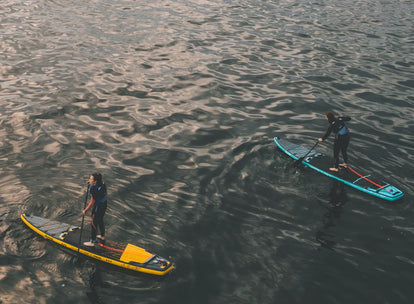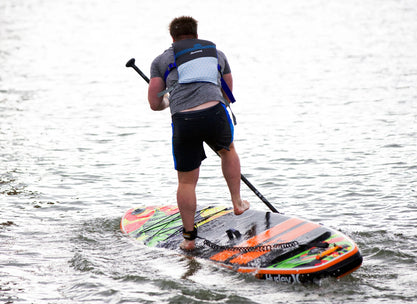One of the best things about starting a new hobby is buying the kit. When it comes to paddle boarding, the most important purchase is your board.
If you’re anything like us, you’ll spend hours doing your research, trying to figure out which board looks like the best and whether it’s suited to your skill level.
It might seem overwhelming with so many options out there, but fear not – we're about to give you the rundown on how boards differ, which should help you narrow down your search.
We’ve also thrown in a few recommendations for good measure, so be sure to check them out:
Board type

First things first, let's decide if you want an inflatable or solid board. Sure, solid boards have their perks, but if you want to take your SUP on the go (and who doesn't?), inflatable is the way to go.
They're easy to transport since they pack down into a backpack, and they won't break the bank either. Plus, once inflated, they're just as rigid as their solid counterparts.
Crucially, inflatable SUPs are also typically less expensive than solid SUPs, making them a more budget-friendly option for beginners or those who want to try paddle boarding without investing too much money upfront.
They are also more forgiving when it comes to accidental collisions, making them a safer choice for kids or beginners who are still getting the hang of the sport.
For beginners, we recommend the Aquaplanet MAX SUP. This beauty provides maximum balance on the water, so you won't be falling off anytime soon (don’t hold us to that!).
As you get more serious about the sport, you might want to also invest in a solid board which has the performance edge – but you’ll only notice that once you start to take things up a notch.
Board shape

The shape of your board will affect its stability and manoeuvrability. Boards are designed for different bodies of water, so consider where you’ll be spending most of your time.
There are three basic types of paddleboards: surf (short and carry less weight when still) , allround (rounded nose wider and thicker for stability) , and flatwater/race (long, thin and fast) . If you’re not sure, don’t worry, an allround paddleboard is a great choice. It’s versatile enough to handle rivers, calm seas, and even small waves.
Our pick is the Aquaplanet ALLROUND TEN SUP. It’s fun, responsive, and lightweight, at 5" thick its at the lower rider weight range (up to 90kg) but if you are within that, there is no need for bigger, making it perfect for long paddles and even messing around in surf.
But, if you want a little more stability and speed, then the Aquaplanet PACE SUP is the way to go. Its signature pointed shape lets you cut into the water smoothly, and its extra thickness (6") provides supreme stability and buoyancy.
Board capacity

The weight capacity of your board is important because it determines how much weight it can support. You'll want to choose a board that can support your weight plus any gear you'll be carrying.
If you're a beginner, you may want to choose a board with a higher weight capacity for maximum stability, as you’re sure to be hauling around a fair bit of kit.
As you get more skilled on your board, you might shed some of that gear, enabling you to go for a nimbler SUP.
Each board on our website has a recommended rider weight, so make sure to check that out before you make your final decision.
That’s about all there is to it when picking a paddle board. However, if you’re unsure, you can try our paddle board calculator or always call our customer service team on 01225 982555 and they’ll happily answer any questions you have.


